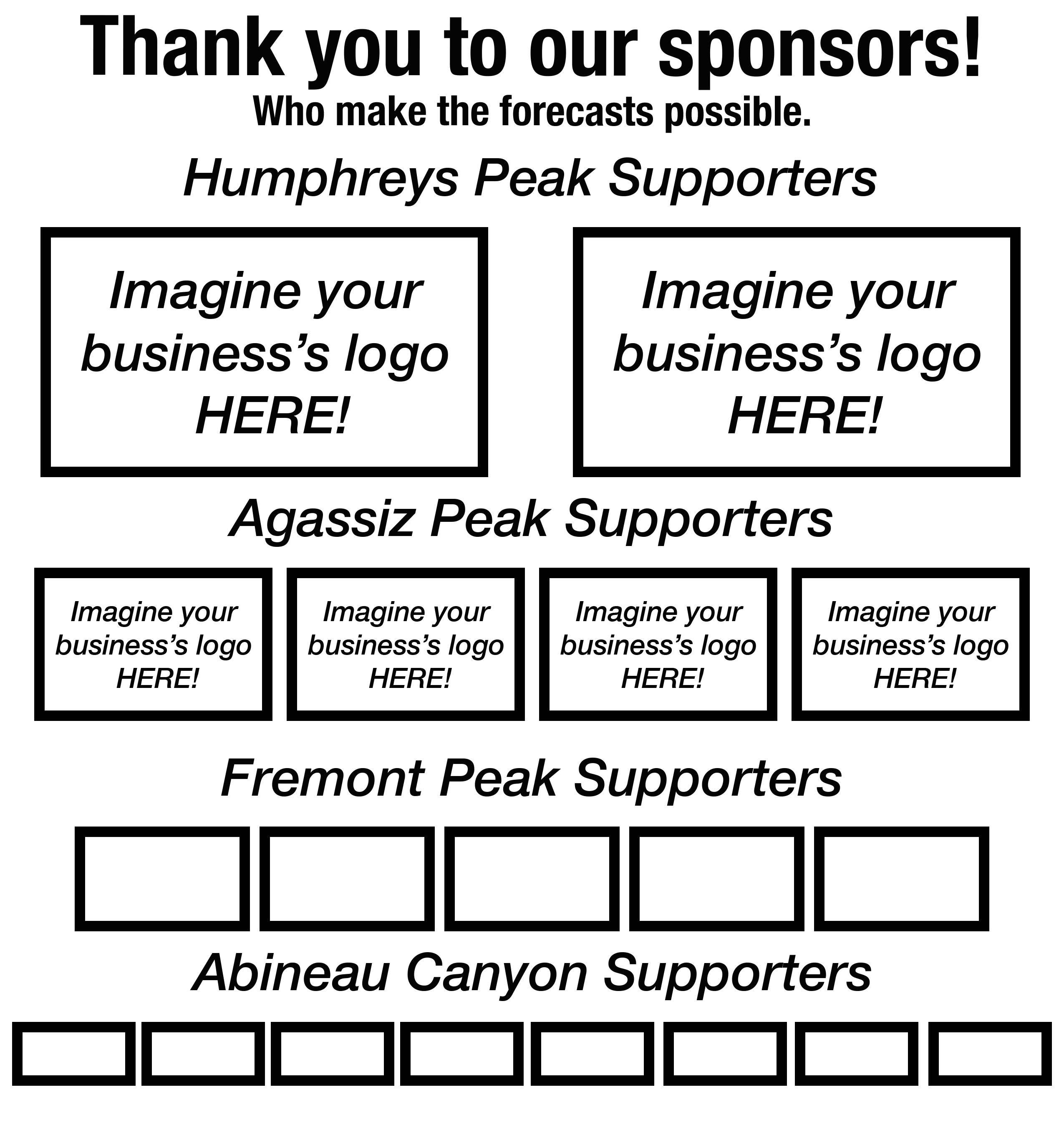Snowpack Summary for Saturday, April 7, 2018 2:17 PM Last Summary of The 2017/2018 Season
This summary expired Apr. 09, 2018 2:17 PM
Flagstaff, Arizona - Backcountry of The San Francisco Peaks and Kachina Peaks Wilderness
Overall
Thank you for a great Mikee Linville fundraiser last weekend! The funds will provide scholarships for future avalanche course scholars. This will be our last snowpack summary for 2017/2018, unless a significant weather event warrants an update.
No human triggered avalanches, nor significant slab avalanches have been reported this season. At higher elevations, enough snow may exist to create an avalanche, though with snow depths ranging from 0 to @100 cm, size may be small to moderate.
Changing weather can create a corresponding increase in the avalanche danger, as well as change the type of avalanche problems you may encounter. Currently with the warm spring weather, wet avalanches are your most likely problem. Wet slide possibilities are mitigated somewhat by the relative lack of snow in starting zones, especially on warmer/sunny aspects.
Backcountry travel can be challenging due to the shallow, or nonexistent snowpack at lower elevations. Logs and rocks are a significant hazard. Melt/freeze crusts have developed on all aspects and elevations (that have snow). Crampons may be helpful.
At this point, we have received only 35% of our average seasonal snowfall at 10,800 feet: with 95 inches year to date snowfall, and an average of a 25 inch (63 cm) base depth on shaded and sheltered slopes. Last season snow total on this date was 328".
No human triggered avalanches, nor significant slab avalanches have been reported this season. At higher elevations, enough snow may exist to create an avalanche, though with snow depths ranging from 0 to @100 cm, size may be small to moderate.
Changing weather can create a corresponding increase in the avalanche danger, as well as change the type of avalanche problems you may encounter. Currently with the warm spring weather, wet avalanches are your most likely problem. Wet slide possibilities are mitigated somewhat by the relative lack of snow in starting zones, especially on warmer/sunny aspects.
Backcountry travel can be challenging due to the shallow, or nonexistent snowpack at lower elevations. Logs and rocks are a significant hazard. Melt/freeze crusts have developed on all aspects and elevations (that have snow). Crampons may be helpful.
At this point, we have received only 35% of our average seasonal snowfall at 10,800 feet: with 95 inches year to date snowfall, and an average of a 25 inch (63 cm) base depth on shaded and sheltered slopes. Last season snow total on this date was 328".
Near and Above TreelineExpect to find new melt/freeze crusts on all aspects. Crampons may be helpful. Spot your lines before descending, coverage is thin and rocks should be expected. The best coverage will be found on northerly and easterly slopes.
Without consistent freezing temperatures, the snowpack loses cohesion. If you experience postholing, saturated snow, or free water in the snowpack, it is unsupportable and potentially hazardous.
Without consistent freezing temperatures, the snowpack loses cohesion. If you experience postholing, saturated snow, or free water in the snowpack, it is unsupportable and potentially hazardous.
Strong sun and rapid warming correspond to rising avalanche danger. Roller balls, pinwheels, sloppy wet snow, or loose snow sloughing are all signs of instability. Stay off of and out from under steep slopes when these signs are present.
New snow, especially when accompanied by wind, can cause a corresponding rise in avalanche danger. Be alert to changing conditions and avoid recent deposits of wind drifted snow characterized by their smooth, rounded appearance. Look for signs of instability such as cracking in the snow surface, collapsing or whumphing, or the most obvious sign of instability - other avalanches!
- Eric Trenbeath (last Utah, Abajo advisory for the 2017-18 season)
Below TreelineIt's getting thin out there. North and Easterly slopes above 10,000 ft will be your best bet for sufficient coverage to ski/board.
Final Thoughts
Backcountry Permits are required for travel in the Kachina Peaks Wilderness and available at local USFS locations, as well as at the Agassiz Lodge on Saturday and Sunday until 11 a.m.
Uphill travel on terrain within the Arizona Snowbowl ski area is open. Please refer to www.flagstaffuphill.com and https://www.snowbowl.ski/the-mountain/uphill-access/ for details.
Uphill travel on terrain within the Arizona Snowbowl ski area is open. Please refer to www.flagstaffuphill.com and https://www.snowbowl.ski/the-mountain/uphill-access/ for details.
Weather
Last updated on Thursday April 5, 2018
Springtime warmth and dry breezy conditions characterized the past week. Temperatures have been mostly above normal for this time of year. The mountain snowpack has responded accordingly by sublimating, evaporating and melting. What little snow remains is rapidly moving towards an isothermal state where all temperature gradient within the snowpack is lost, resulting in a temperature reading of near 0° C throughout the snowpack. Under this condition the snowpack generally gains density and strength, particularly as it freezes up at night. However it should be noted, that any remaining weaknesses have the potential of changing very quickly from stable to unstable as the snowpack rapidly warms during the day, bonds melt, free water percolates and snow strength is lost.
Look into next week, a low pressure system will pass to our north over the weekend bringing cooler temperatures, windy and gusty conditions and a chance for light snow showers at high elevations. Accumulation is expected to be minimal. This will be followed by building high pressure and a warming trend for the remainder of the week.
On the evening of April 5th the Inner Basin SNOTEL site (Snowslide) reported a snow depth of 8 inches (20 cm) at 9,730 ft and Arizona Snowbowl reported a settled base of 36 inches (91 cm) at 10,800 ft. So far this winter 95 inches (241 cm) of snow have fallen at the mid-mountain study site. Since March 29th , SNOTEL temperatures have ranged between 28° on March 30th and 58° F on March 31 st. For the same period, the AZ Snowbowl Top Patrol Station (ASBTP - elev. 11555 ft) temperature ranged between 25° on April 3rd and 49° F on April 1st .
Springtime warmth and dry breezy conditions characterized the past week. Temperatures have been mostly above normal for this time of year. The mountain snowpack has responded accordingly by sublimating, evaporating and melting. What little snow remains is rapidly moving towards an isothermal state where all temperature gradient within the snowpack is lost, resulting in a temperature reading of near 0° C throughout the snowpack. Under this condition the snowpack generally gains density and strength, particularly as it freezes up at night. However it should be noted, that any remaining weaknesses have the potential of changing very quickly from stable to unstable as the snowpack rapidly warms during the day, bonds melt, free water percolates and snow strength is lost.
Look into next week, a low pressure system will pass to our north over the weekend bringing cooler temperatures, windy and gusty conditions and a chance for light snow showers at high elevations. Accumulation is expected to be minimal. This will be followed by building high pressure and a warming trend for the remainder of the week.
On the evening of April 5th the Inner Basin SNOTEL site (Snowslide) reported a snow depth of 8 inches (20 cm) at 9,730 ft and Arizona Snowbowl reported a settled base of 36 inches (91 cm) at 10,800 ft. So far this winter 95 inches (241 cm) of snow have fallen at the mid-mountain study site. Since March 29th , SNOTEL temperatures have ranged between 28° on March 30th and 58° F on March 31 st. For the same period, the AZ Snowbowl Top Patrol Station (ASBTP - elev. 11555 ft) temperature ranged between 25° on April 3rd and 49° F on April 1st .
Authored/Edited By: Troy Marino, Derik Spice









